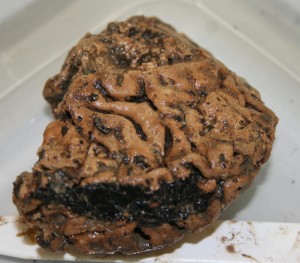 The brain belonging to an Iron Age man has been found in a bog in the U.K. The 2,684 year old soft tissue has remained remarkably well preserved throughout the centuries because of the environment it was in.
The brain belonging to an Iron Age man has been found in a bog in the U.K. The 2,684 year old soft tissue has remained remarkably well preserved throughout the centuries because of the environment it was in.
Archeologists believe that the brain belonged to a man in his mid thirties. The archeological team believes that the man was hanged due to the injuries on the neck vertebrae which point to a hanging.
Scientists believe that because the brain was submerged in the bog’s liquid, the anoxic marsh proved to have the right levels of oxygen and minerals to “pickle” the brain for ages. Interesting to note that the scientists believe that the man was hanged and then decapitated before being thrown into the bog.
Makes you wonder what else lies in the sediment of the world’s oldest bogs. Probably intact dinosaurs and early humans. Gross.
Full source: Discovery News
2 commentsA human skull dated to about 2,684 years ago with an “exceptionally preserved” human brain still inside of it was recently discovered in a waterlogged U.K. pit, according to a new Journal of Archaeological Science study.
The brain is the oldest known intact human brain from Europe and Asia, according to the authors, who also believe it’s one of the best-preserved ancient brains in the world.
“The early Iron Age skull belonged to a man, probably in his thirties,” lead author Sonia O’Connor told Discovery News. “Cause of death is rarely possible to determine in archaeological remains, but in this case, damage to the neck vertebrae is consistent with a hanging.”
“The head was then carefully severed from the neck using a small blade, such as a knife,” added O’Connor, a post-doctoral research associate at the University of Bradford. “This was used to cut through the throat and between the vertebrae and has left a cluster of fine cut marks on the bone.”
The brain-containing skull was found at Heslington, Yorkshire, in the United Kingdom. O’Connor and her team suspect the site served a ceremonial function that persisted from the Bronze Age through the early Roman period. Many pits at the site were marked with single stakes. The remains of the man were without a body, but the scientists also found the headless body of a red deer that had been deposited into a channel.
Laser imaging, chemical analysis and other examinations revealed that the brain naturally preserved over the millennia. The scientists found no evidence for bacterial or fungal activity, and described the tissue as being “odorless…with a resilient, tofu-like texture.”
The condition of the brain is remarkable for its age.
“In the air, even in the chill of a hospital mortuary, brain tissue very quickly decays to liquid before muscle and other soft tissues show much evidence of decay,” O’Connor said.
She and her colleagues suggest that a fortuitous series of events — for the brain and science, not the victim — led to the organ’s preservation. Shortly after the man was killed, his head must have been placed, or fallen into, the waterlogged pit that was free of oxygen. While other soft human body parts may not preserve well under such conditions, the wet environment appears to be perfect for keeping brains “fresh,” “due to the very different chemistry of brain tissue,” O’Connor said.
The researchers don’t think the violent way the man was killed aided his brain’s preservation. While severing his head separated it from the rest of his body, including the bacteria-filled gut, the decapitation “would also have produced a gaping wound that would have been open to immediate infection from micro-organisms involved in putrefaction.” The quick burial in conditions not suited for microbial activity likely prevented that from happening.
In addition to describing this unusually well preserved brain, the journal paper provides the first in-depth study of other prehistoric human brains and soft human tissues discovered by scientists. They include the body of the 5,000-year-old Tyrolean “Ice Man,” the Inca mummies of the high Andes, the tanned bog bodies from across Northern and Western Europe, good condition bodies sealed in lead coffins — such as the St. Bees man, and crypt burials at places like Spitalfields Church, London, where bodies with surviving brain tissue were found.
Glen Doran, chair of the anthropology department at Florida State University, told Discovery News that two aspects of the new study immediately struck him as “notable.”
“First,” he said, “such preservation is testimony to the amazing preservation in wet sites. Truly amazing things come out of the muck.”
“The second, he added, “is the absolutely stellar analysis brought to bear on this special find.”
Based on this discovery and other known prehistoric, intact human brains, he agrees that rapid burial in an aqueous environment, as well as near-continual submersion, are essential to human brain tissue preservation.
“The cranium is well designed to protect the brain in life and can, under the right circumstances, remain on duty long after the normal expectation of service,” he said.




